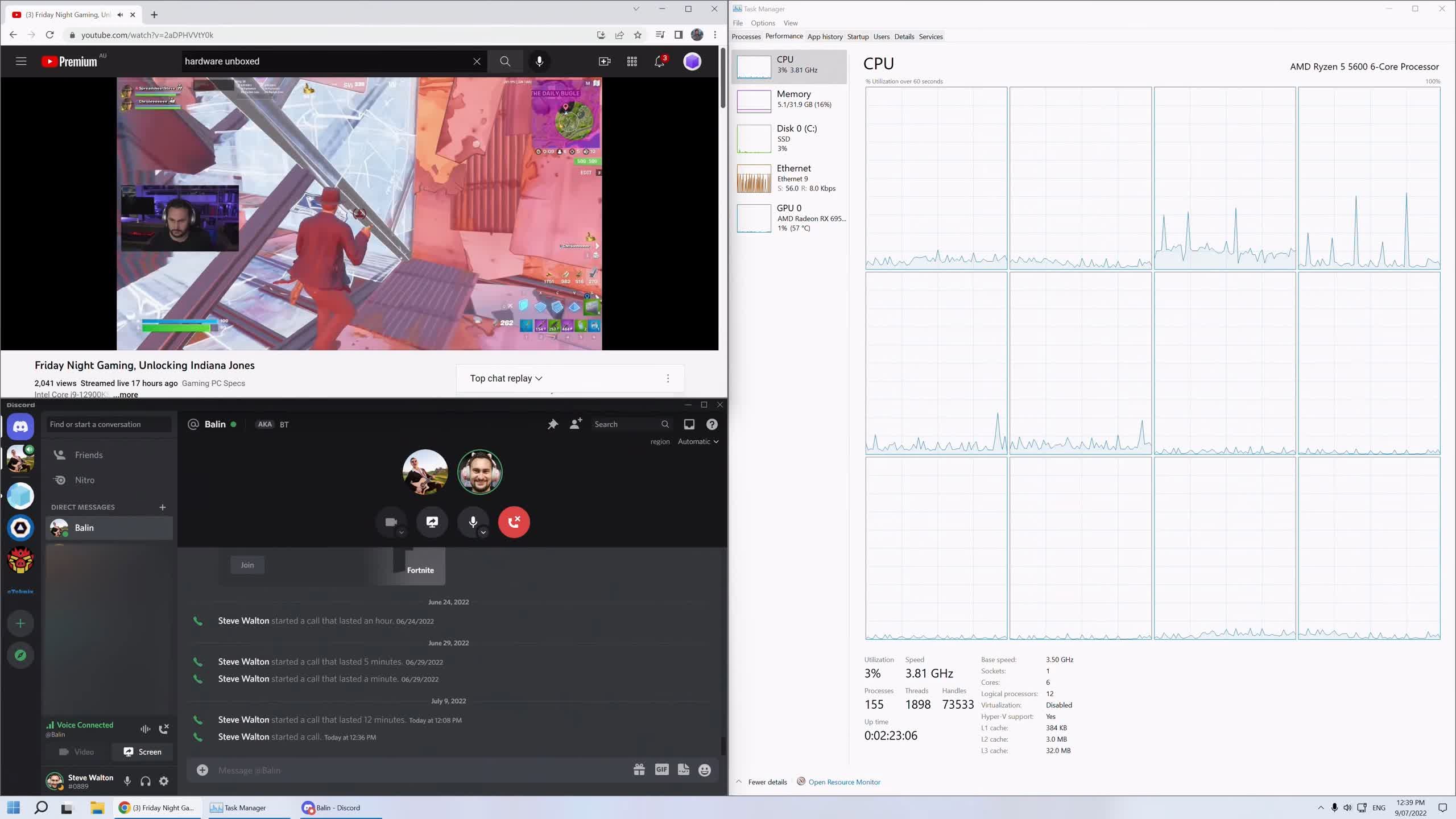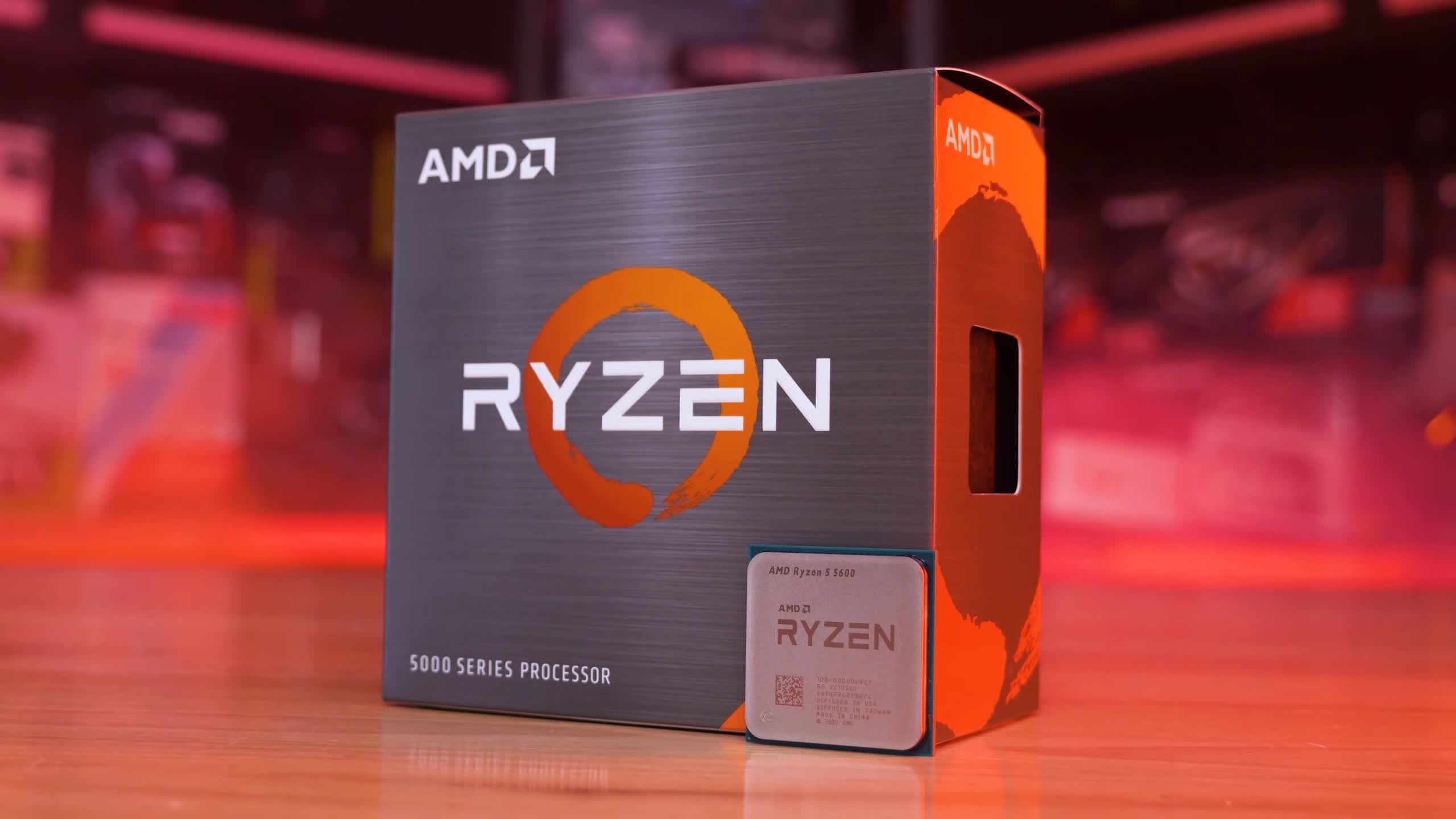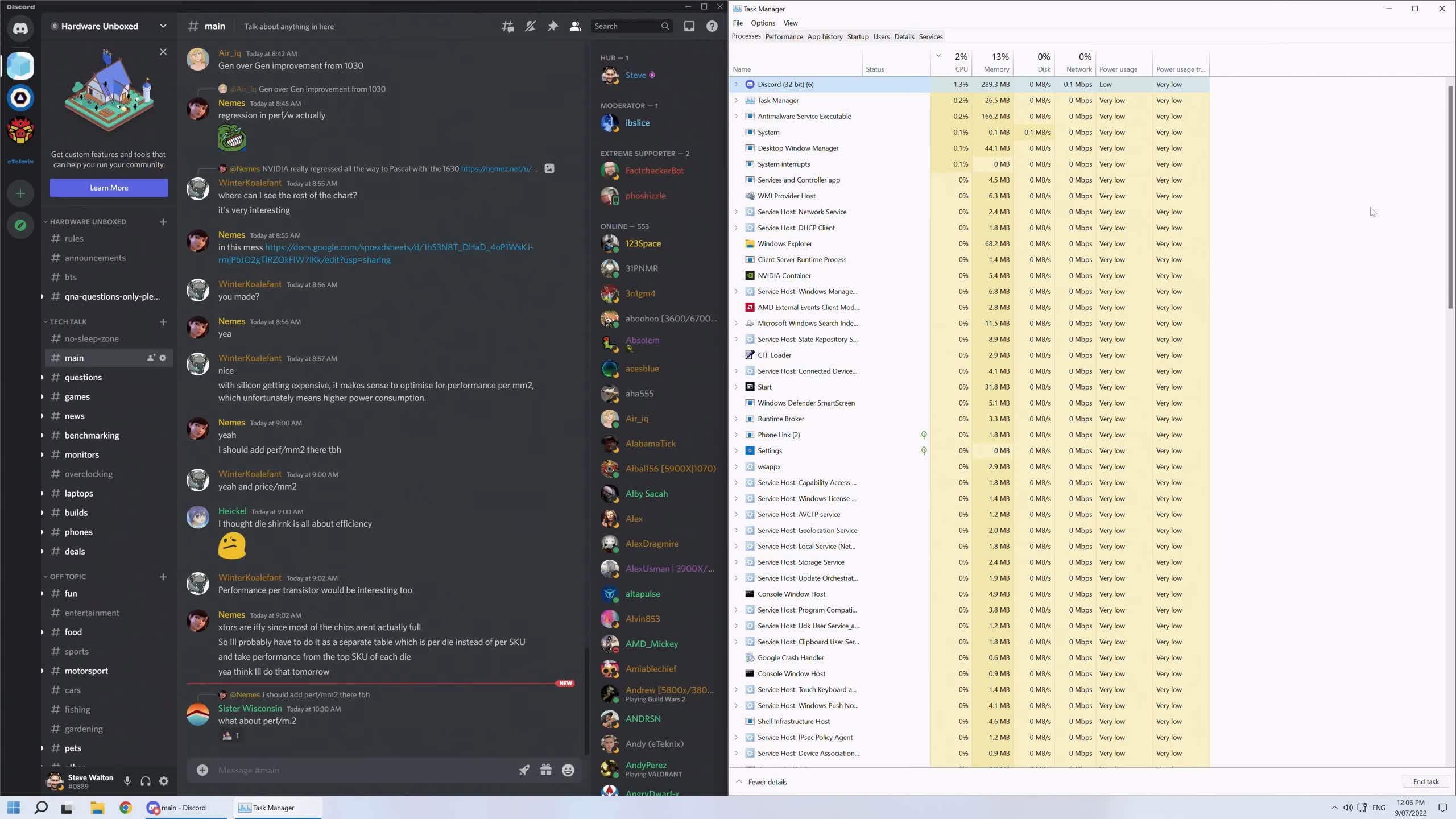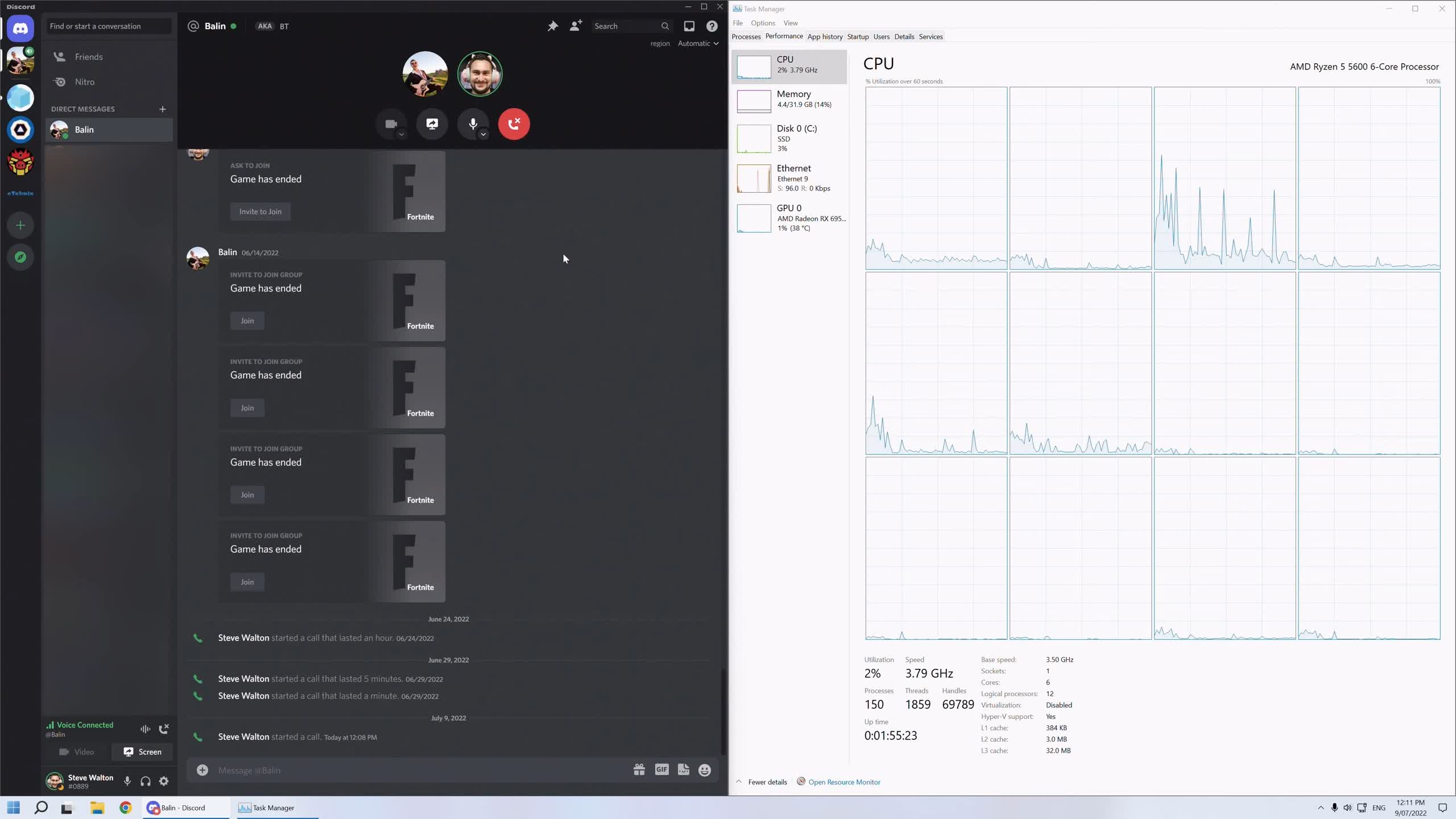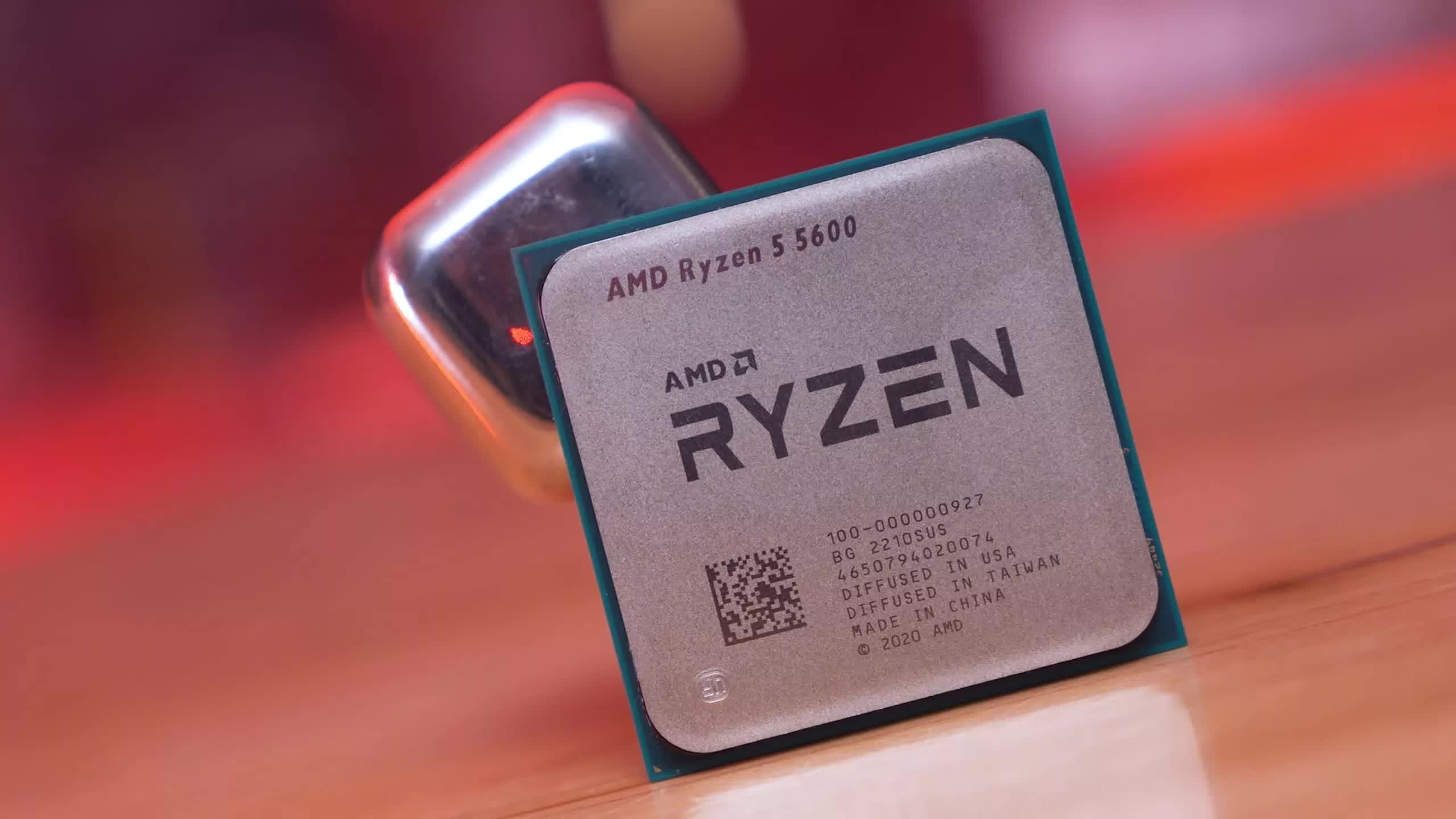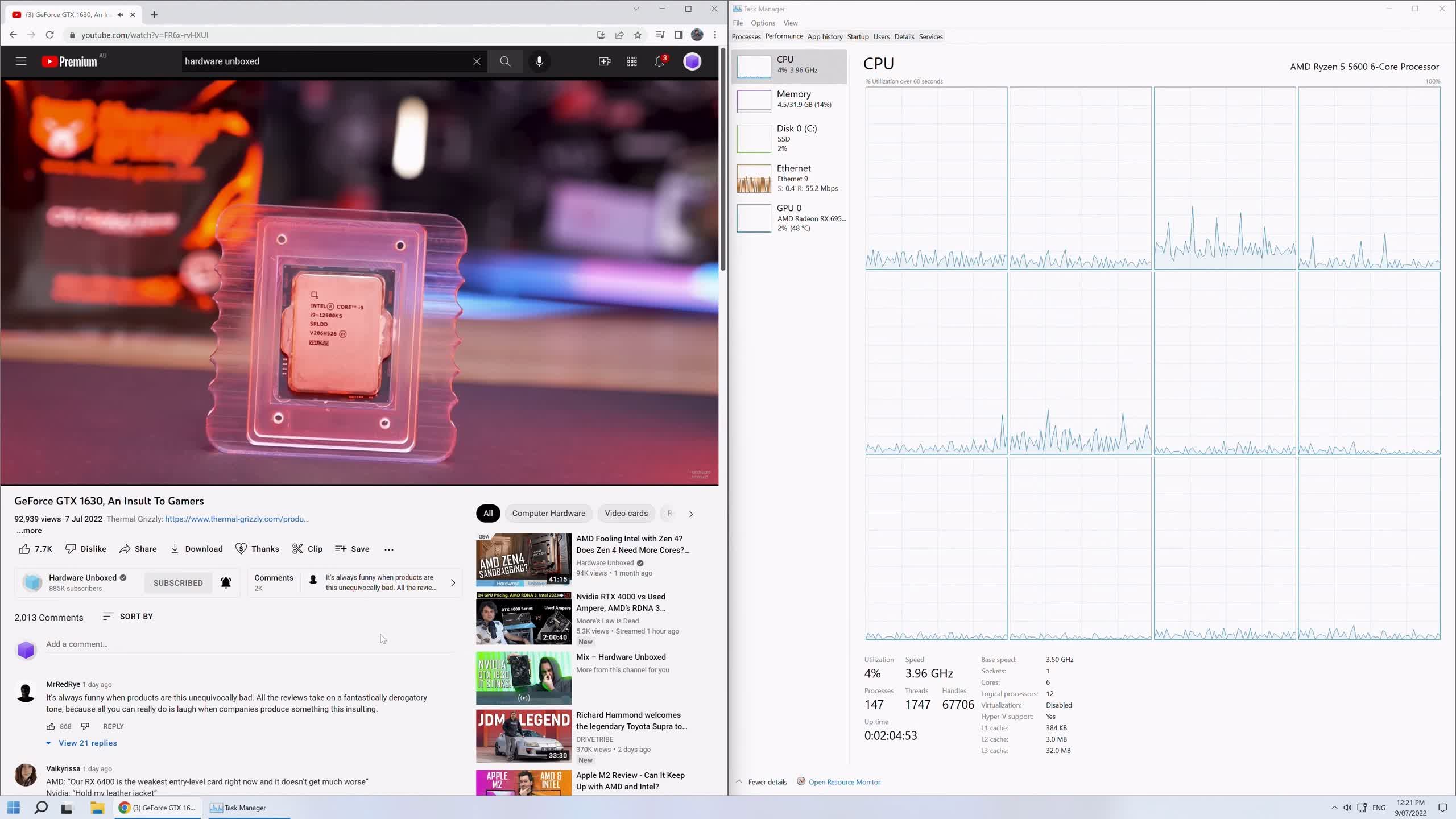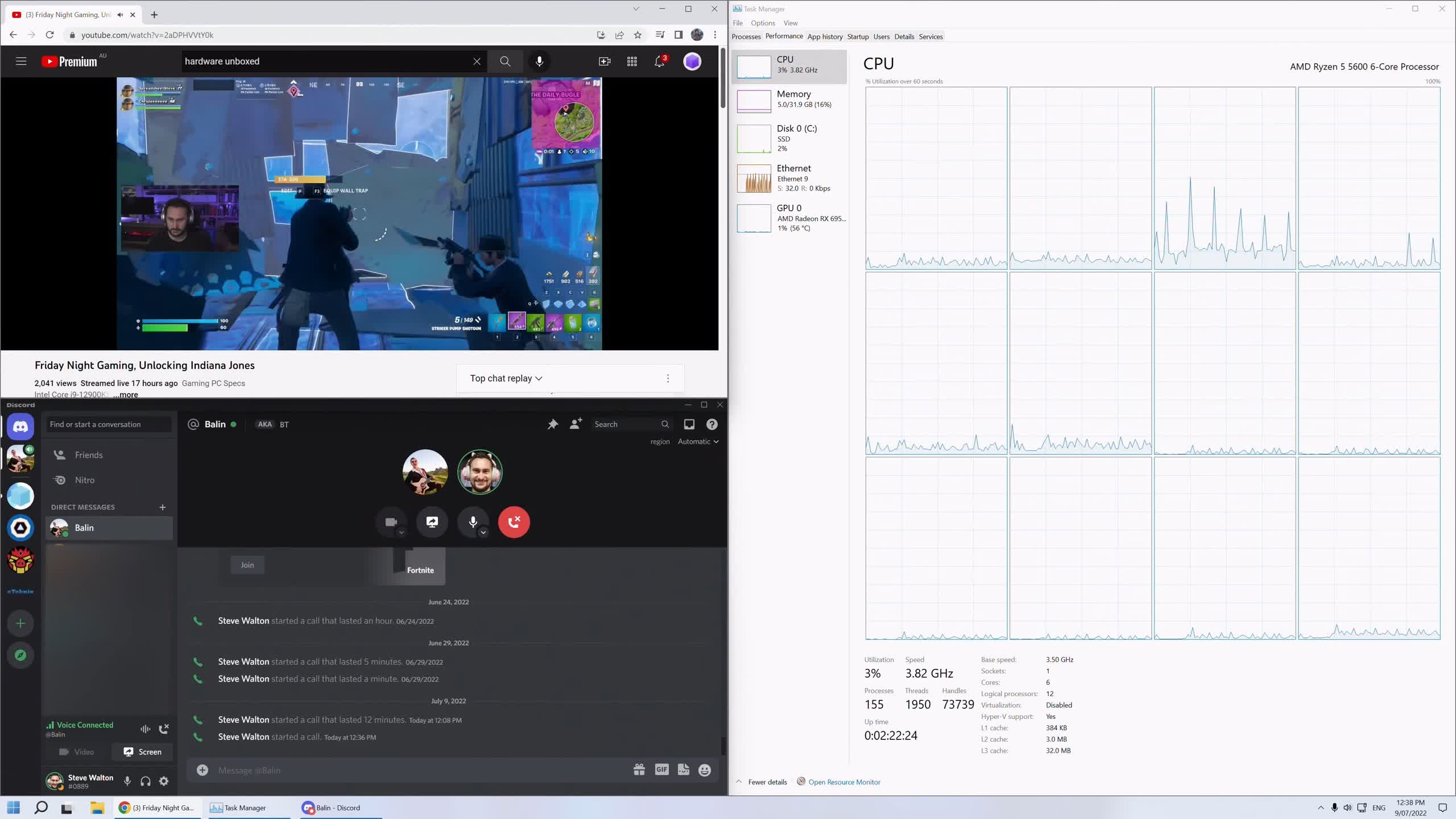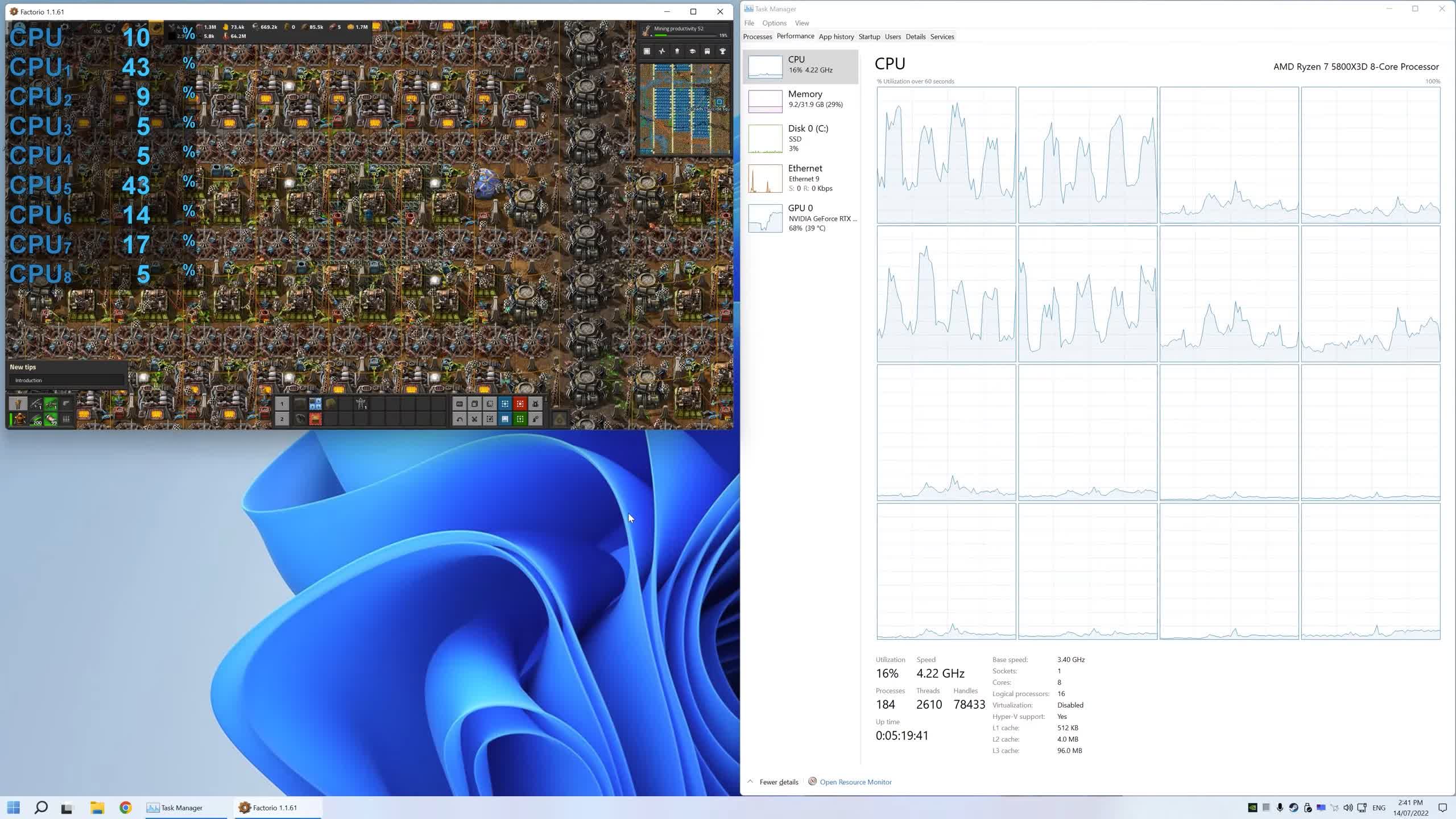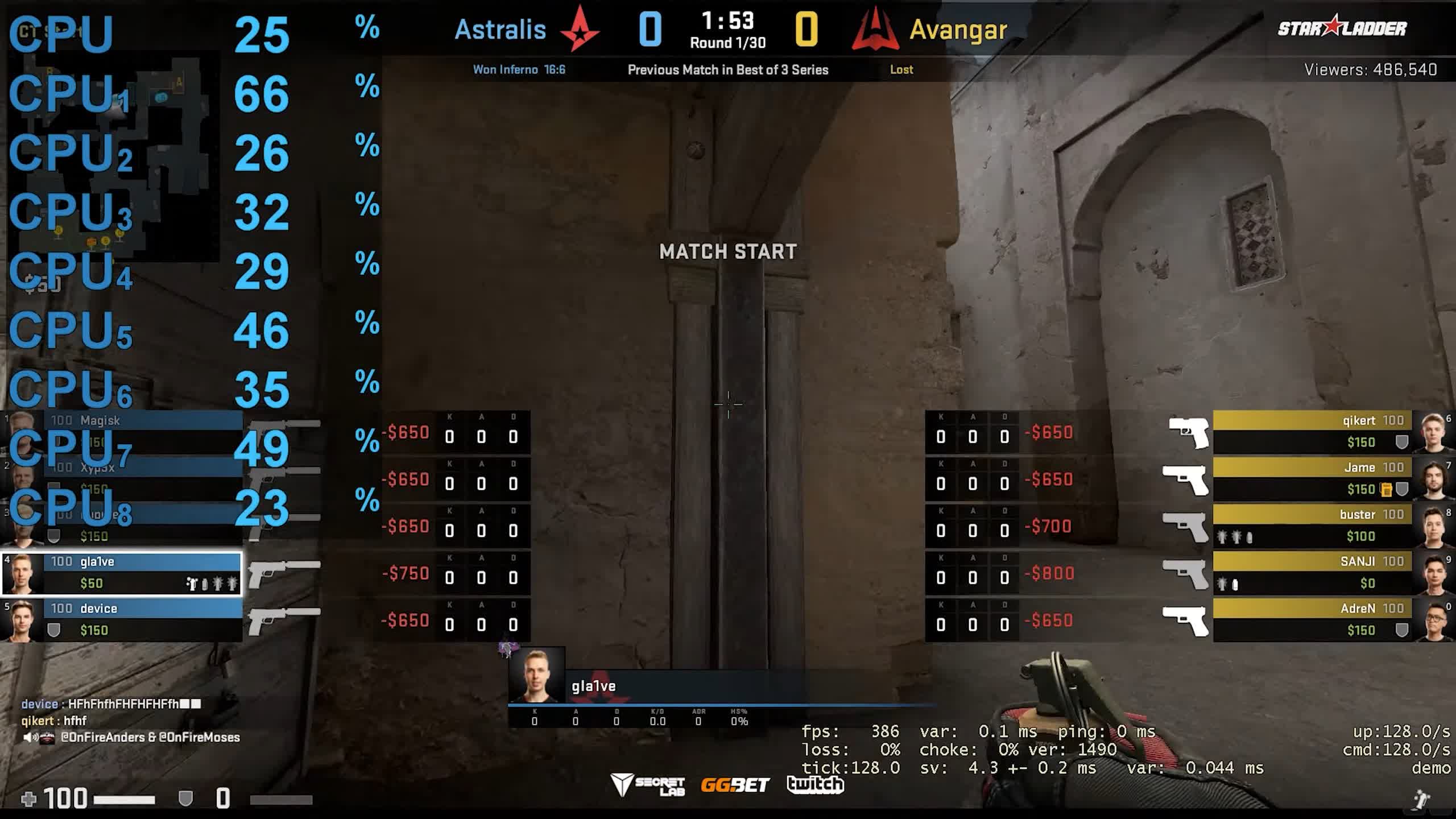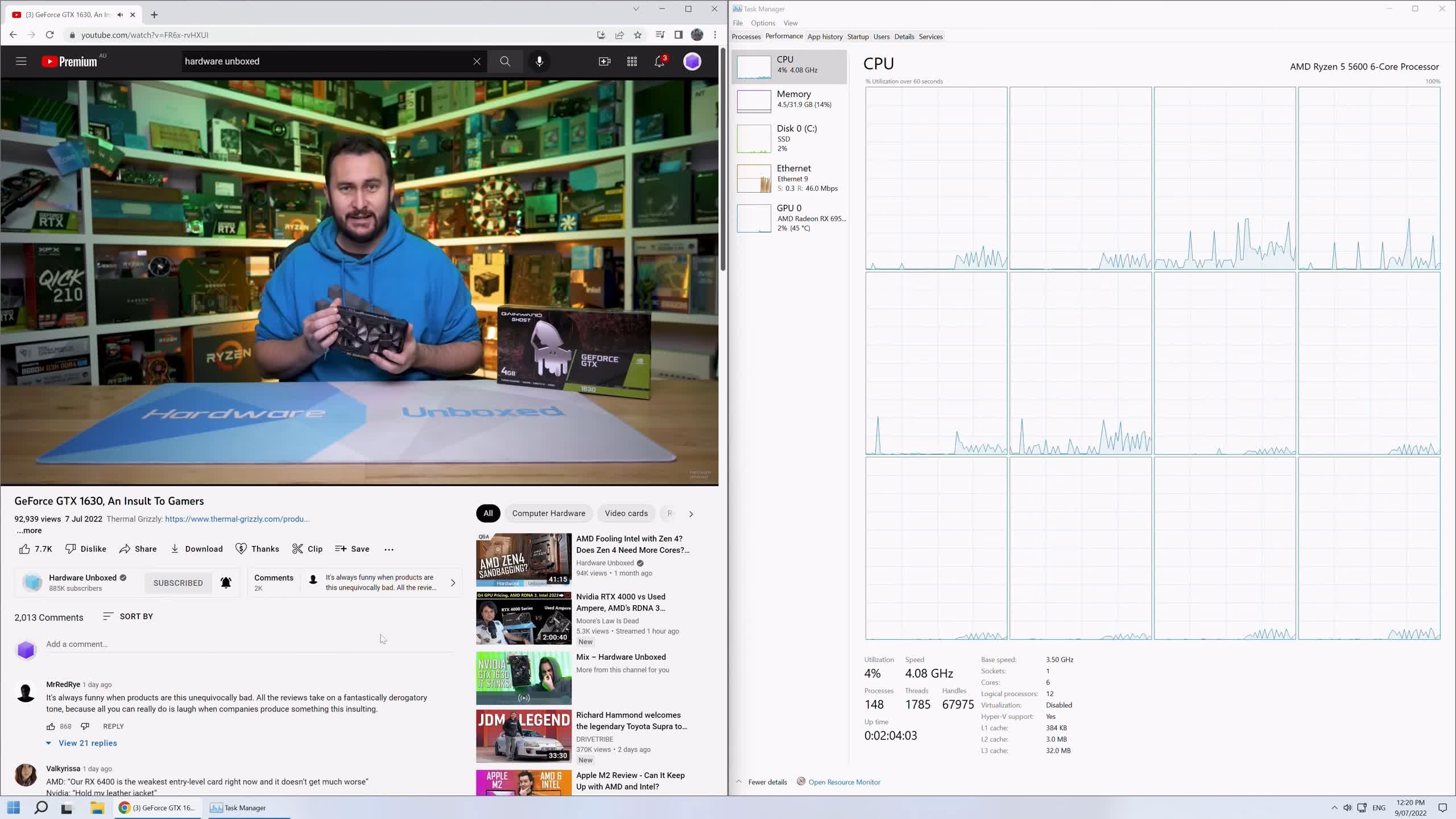In today's article we're going to look at multitasking performance when gaming. This is a complex subject and one that is often misunderstood by gamers, especially when discussing CPU performance.
For example, recently we compared the Ryzen 5 5600 and Ryzen 7 5700X in a wide range of games and found that on average the 8-core CPU was just 5% faster, which wasn't terribly surprising, but there were a surprising number of readers and viewers who claimed the data didn't reflect real-world gaming performance.
The reasoning is that gamers often watch or listen to YouTube videos while gaming, they have other programs such as Discord open, allowing them to chat with teammates, and sometimes they even stream/screen share using Discord. The claim is that these applications require more processing power / cores and therefore the 5700X will end up being noticeably faster than the 5600.
We've done our best to explain that these relatively light background tasks don't weigh heavily on modern processors, and provided you have enough system memory, they won't make a noticeable difference. We've also explained that anyone can easily verify this for themselves by running said programs and monitoring system resources.
But the persistence is such that many gamers still claim you need 8 cores for gaming if you want to watch a YouTube video and chat with friends on Discord. Of course, claiming you need or don't need a certain core count for gaming is wrong in and of itself, as we've explained you're much better off talking about overall CPU performance.
For this test we'll be using the Ryzen 5 5600 and Ryzen 7 5700X once again and comparing them with various active background tasks. Based on your feedback it sounds like many of you do have a YouTube video playing in the background or on a second monitor while you game, often just playing music or a podcast for some background noise. Then as you'd expect, most have Discord open with a few active servers and a chat room.
Setting Up the Test
We thought the best place to start would be with the Ryzen 5 5600 installed and then with the system at idle, monitor how many resources these individual workloads require.
Starting with Discord, open with a few active chat servers, but mostly idle. Here we see that Discord is using between 1 - 2% of our Ryzen 5 5600 processor, a negligible load that we don't expect to impact gaming performance, but we'll look at that soon.
We've seen quite a few comments claiming that the voice processing features of Discord require a lot of CPU overhead, stuff like noise reduction, echo cancellation and auto gain control. We enabled all of those features and then made a test call. This made very little difference to the CPU usage of Discord, generally hovering around 2% with occasional brief spikes to 3, 4 and even 5%. But by and large CPU usage was now at 2-3%.
Now, for streaming we've always recommended you go for at least the next tier in CPU performance as this is a bit more than just a background task and typically requires quite a lot of processing power. However, with Discord the CPU usage was still fairly low and only a single core is used heavily, typically hovering around 11% with brief spikes as high as 15%, so you could probably get away with the Ryzen 5 5600 with minimal impact to your frame rate, but again, we'll look at this shortly.
Next, we wanted to measure CPU usage with the Ryzen 5 5600 when playing a 4K YouTube video in the Chrome browser. It's important to note that opening 10, 20, 30 or more browser tabs has little to no impact on CPU usage providing those tabs are idle. They will eat up system memory if available though as that allows for seamless switching of tabs.
With a 4K 60fps video playing, the Ryzen 5600 saw an average CPU usage of just 4%, lower than even we were expecting. There was the very brief and occasional spike to ~7 to 9%, but typically utilization was very low. Also if we understand user feedback correctly, most aren't actually watching the video while gaming, or at least not very closely, and therefore opt to 1080p playback or lower, which makes even more sense for those with more limited internet connections.
Therefore we measured utilization while playing a 1080p 60fps video and found that the average CPU usage halved to just 2%, but often sat at 1% with occasional spikes as high as 5%.
We think the most realistic and likely configuration would be Discord running with a few active servers plus an active call using the voice processing features along with Chrome open playing a 1080p video, and for that we used a recent 1080p 60fps stream. With both of those applications active average CPU usage sat at 4%, with brief spikes as high as 9%.
The bulk of our testing was performed using this configuration for this article. We could do more testing like this in the future with different configurations, but we felt this was a good starting point. We'll also briefly look at 4K YouTube plus Discord chat and streaming.
To complete our hardware configuration, we're using 32GB of dual-rank, dual-channel DDR4-3200 memory on the MSI X570S Carbon Max WiFi motherboard. The Ryzen 5 5600 and Ryzen 7 5700X were tested alongside a Radeon RX 6950 XT at 1080p and 1440p with SAM enabled.
Benchmarks
Starting with ACC, we see that the 1% low performance of the 5700X and 5600 is basically identical. However, with a video playing while on a Discord call we see that the 1% lows of the 5600 dropped by 10% while the 5700X dropped by just 5%. The margins for the average frame rates remained much the same.

A similar thing is seen at 1440p, the 5700X dropped 4% of its original performance while the 5600 dropped by 7%. Clearly, the 5700X is handling the added load better, but overall the difference is rather miniscule and the 5600 enabled a perfectly smooth gaming experience.
It's also worth noting that we are using medium quality settings with a 6950 XT, so cranking up the visuals will simply shift the load towards the GPU further, which will reduce the margins. We would also see a smaller margin with a lesser GPU installed.
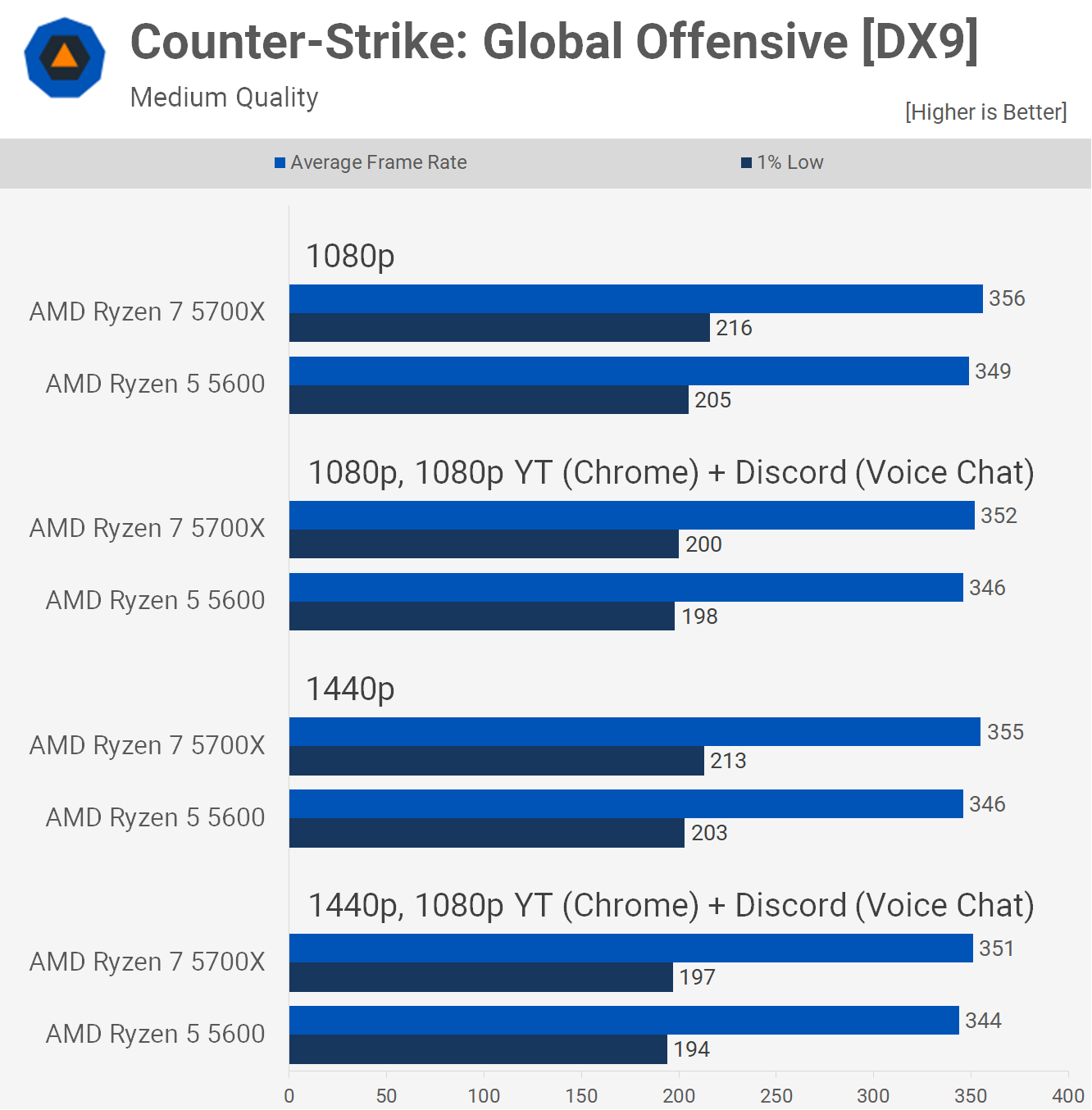
A game that often comes up in these multitasking discussions is Counter-Strike: GO, as competitive esports gamers are after every last frame possible. Thing is though, CS:GO is really limited by core IPC as it's a lightly threaded game, given it uses the DX9 API.
What's interesting here is that the margins actually close up between the 5600 and 5700X with the background tasks active. So where the 5700X was 5% faster with no background tasks, it was repeatedly just a percent faster with YT and Discord active. Either way though, for older games that are thread dependent going from 6 to 8 cores with a modern processor is going to make no difference as much of the CPU is still sitting around doing nothing, even with a YT video playing and Discord active.
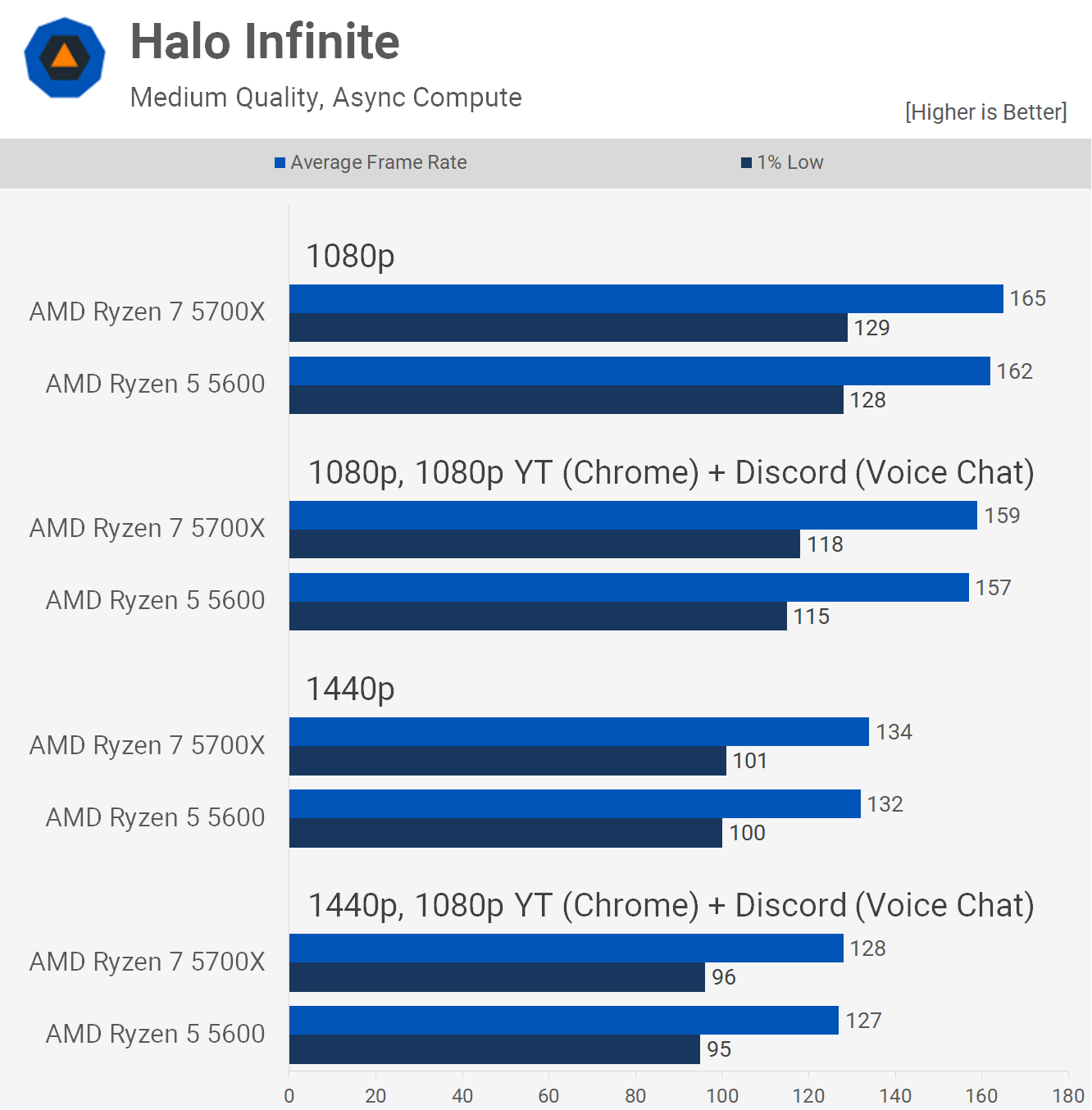
Halo Infinite was also tested using dialed down quality settings but even so we appear to be mostly GPU limited and although the background tasks reduced 1% lows at 1080p by 10% for the 5600, we saw a similar 9% hit for the 5700X.
Increasing the resolution to 1440p which further increased the GPU bottleneck, we see that the multitasking performance hit is no more than 5%. Most gamers playing with higher visual quality settings or a slower GPU will see no perceivable performance hit when watching a YouTube video and chatting on Discord while gaming.
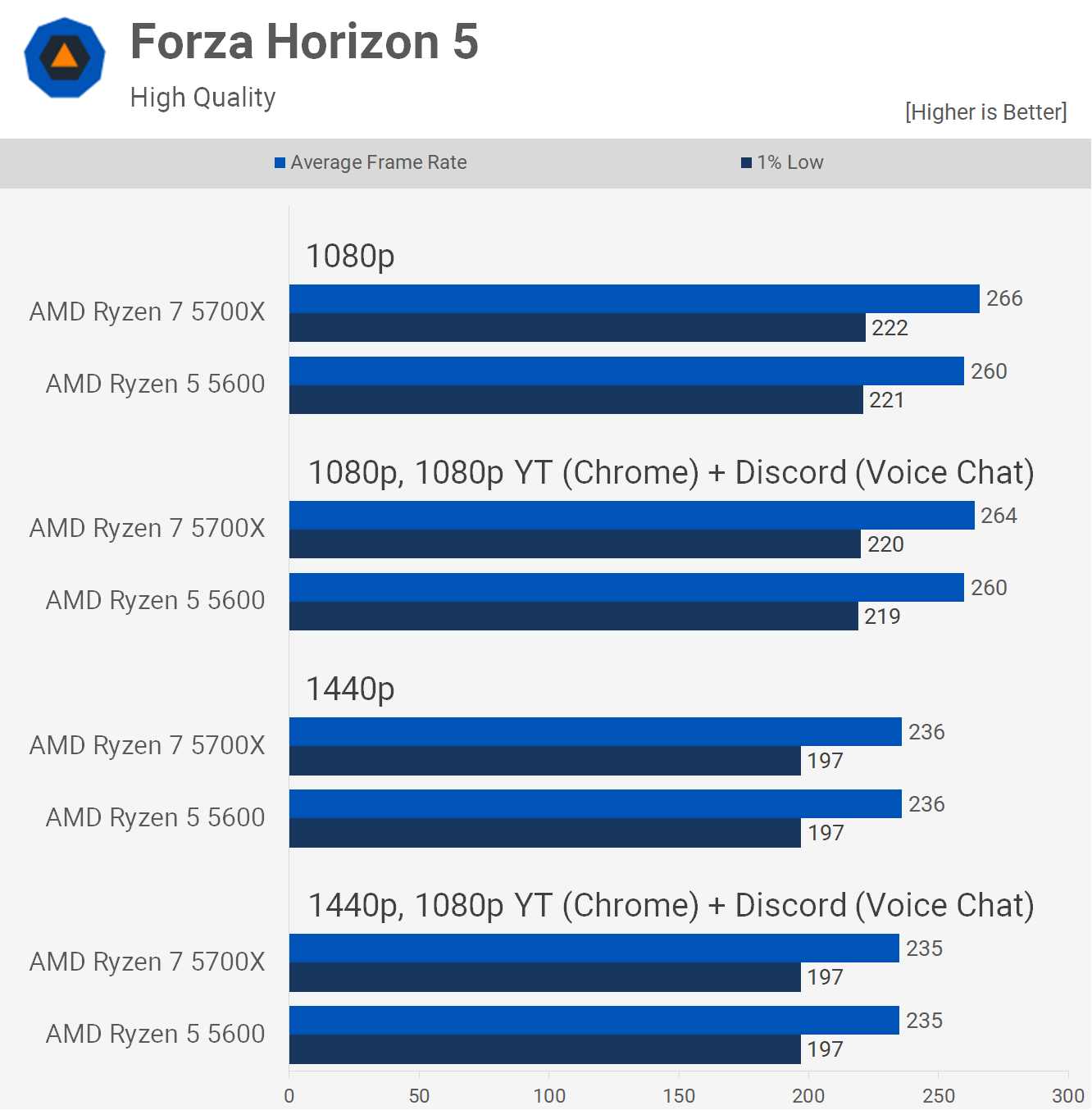
Next we have Forza Horizon 5, another modern game that doesn't use the CPU heavily and as a result the 5600 and 5700X saw no performance drop when running our background tasks, not much more to say here, so let's move on.
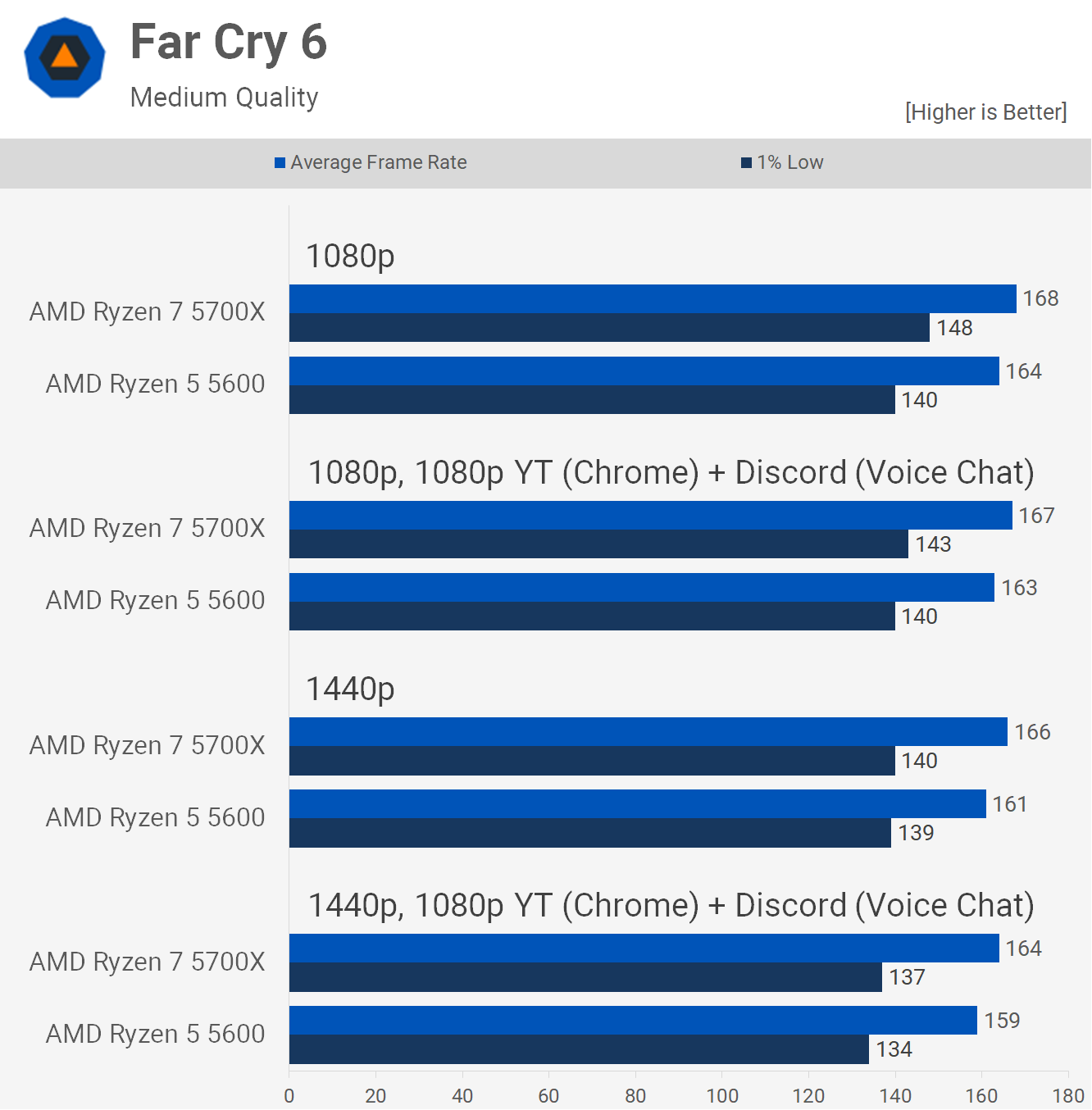
Far Cry 6 is another title that only hammers a few CPU threads and despite the results being heavily CPU limited, the 5600 and 5700X deliver similar results even with the background tasks active. At most we're looking at a 3-4% hit to 1% lows and the reduction was seen for both CPUs.
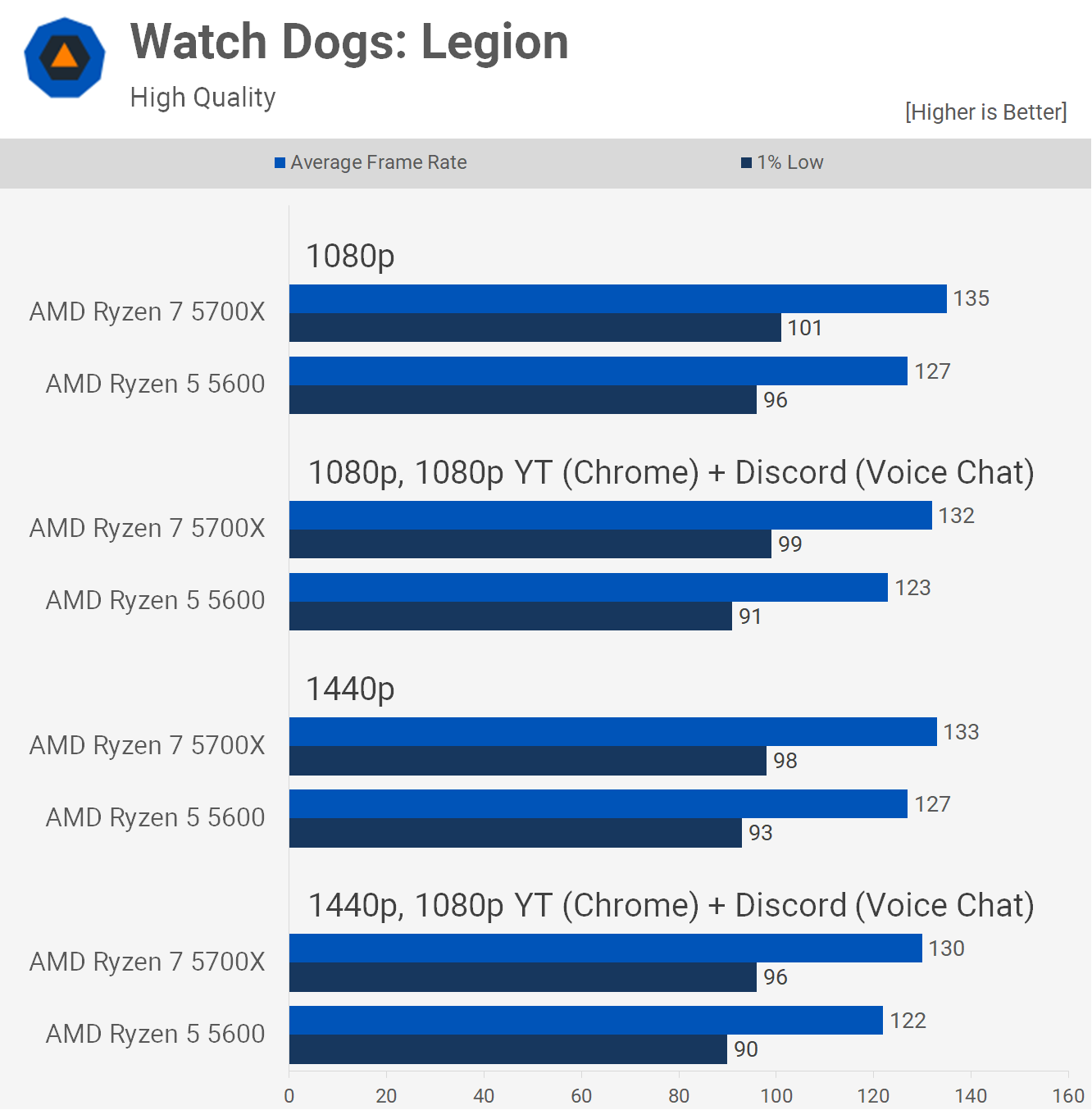
Moving on to Watch Dogs: Legion, which is a CPU demanding title, we see that without any additional applications running the 5700X is 6% faster than the 5600 when comparing the average frame rate, and 5% faster for the 1% lows.
With YouTube playing and Discord active, the average frame rate of the 5700X is 7% greater but the 1% lows are now 9% higher, an improvement of 4% for the 5700X. This is evidence that the extra cores can help, as you'd naturally expect, but even with a demanding title such as Watch Dogs: Legion, the improvement is minimal and won't be something gamers can perceive.
Not only that, but by the time we get to 1440p the margin is eliminated and both CPUs see a 2 to 3% performance hit with the background tasks active.
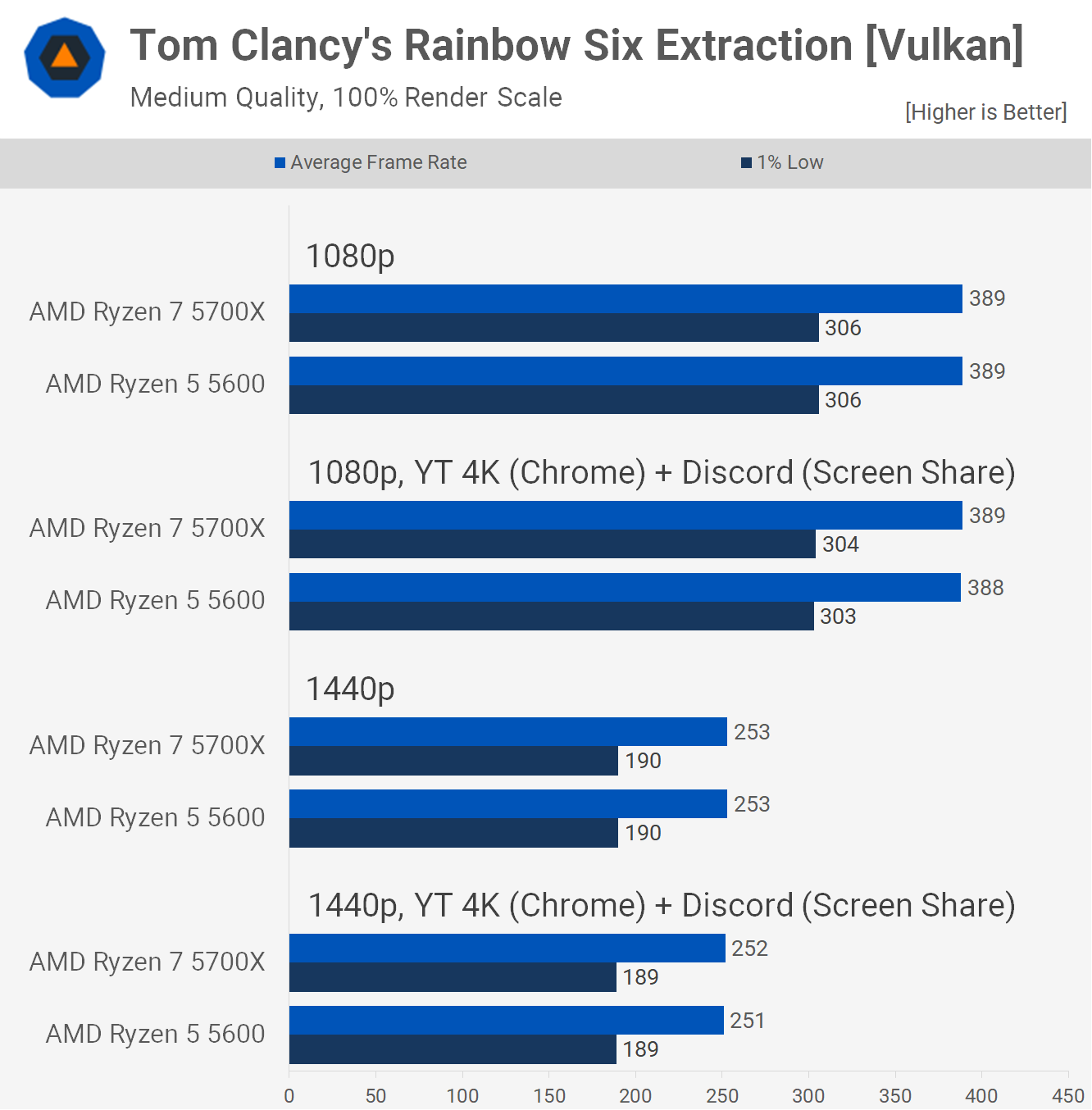
Rainbow Six Extraction can play at hundreds of frames per second using modest hardware and here we're using the medium quality preset. With the background tasks active we saw no performance hit as frame rates remained virtually identical.
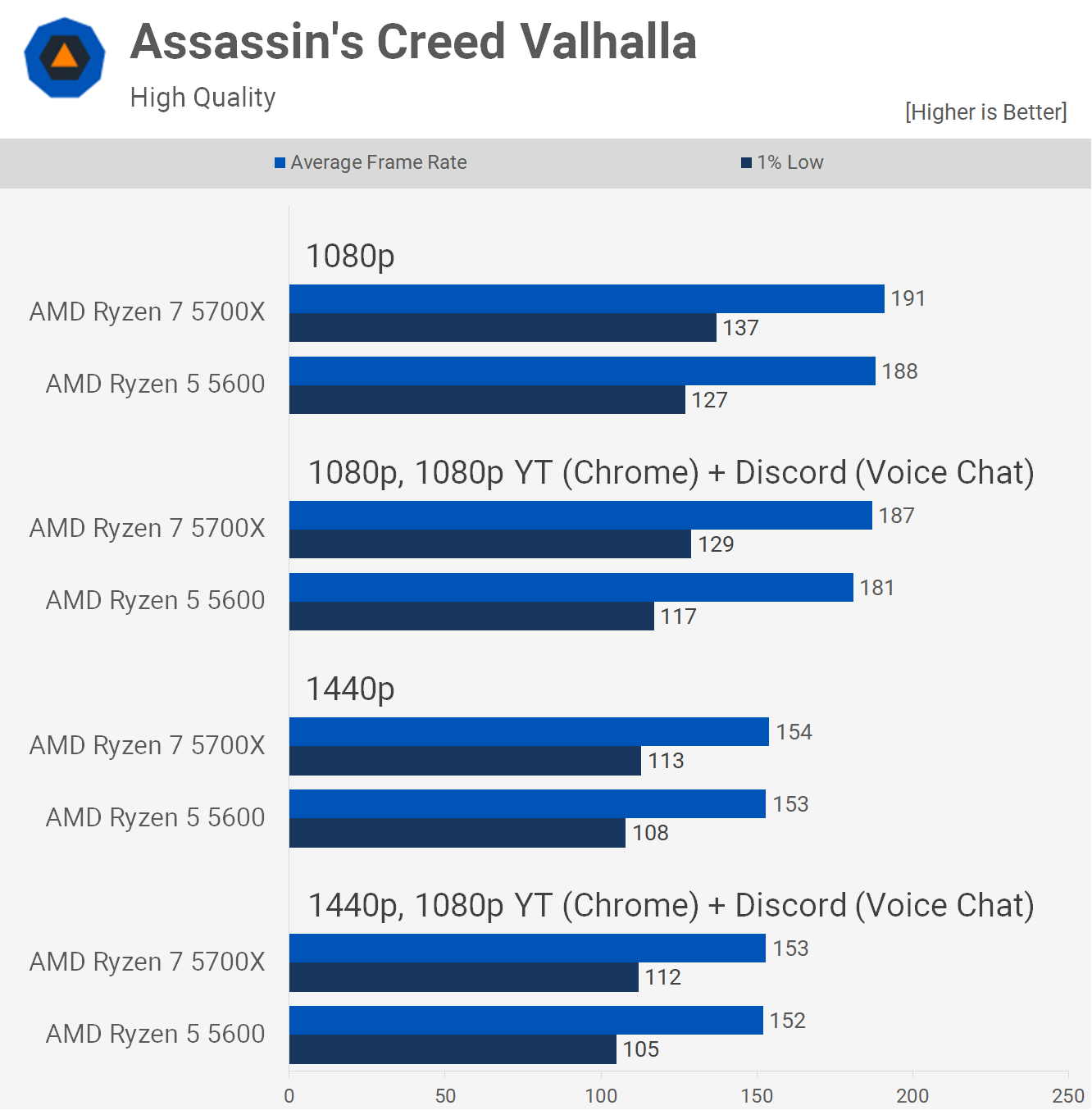
Assassin's Creed Valhalla sees a small performance hit with the background tasks active, particularly to the 1% lows. The 1% of the 5700X dropped by 6%, while the 5600 saw a 8% drop. Again we see how the 8-core processor fares slightly better, though we're talking about a negligible performance delta.

Last up we have Tom Clancy's Rainbow Six Siege which we have tested with a few different configurations. We'll start with 1080p YouTube + Discord voice chat data. At 1080p the 5700X and 5600 saw a mere 3% hit to 1% lows with the background tasks active. Interestingly, the 5700X saw a bigger hit to the average frame rate, suggesting that it was able to drive higher maximum frame rates without the background tasks active.
In either case the gaming experience was identical using either CPU, with or without our background applications running.
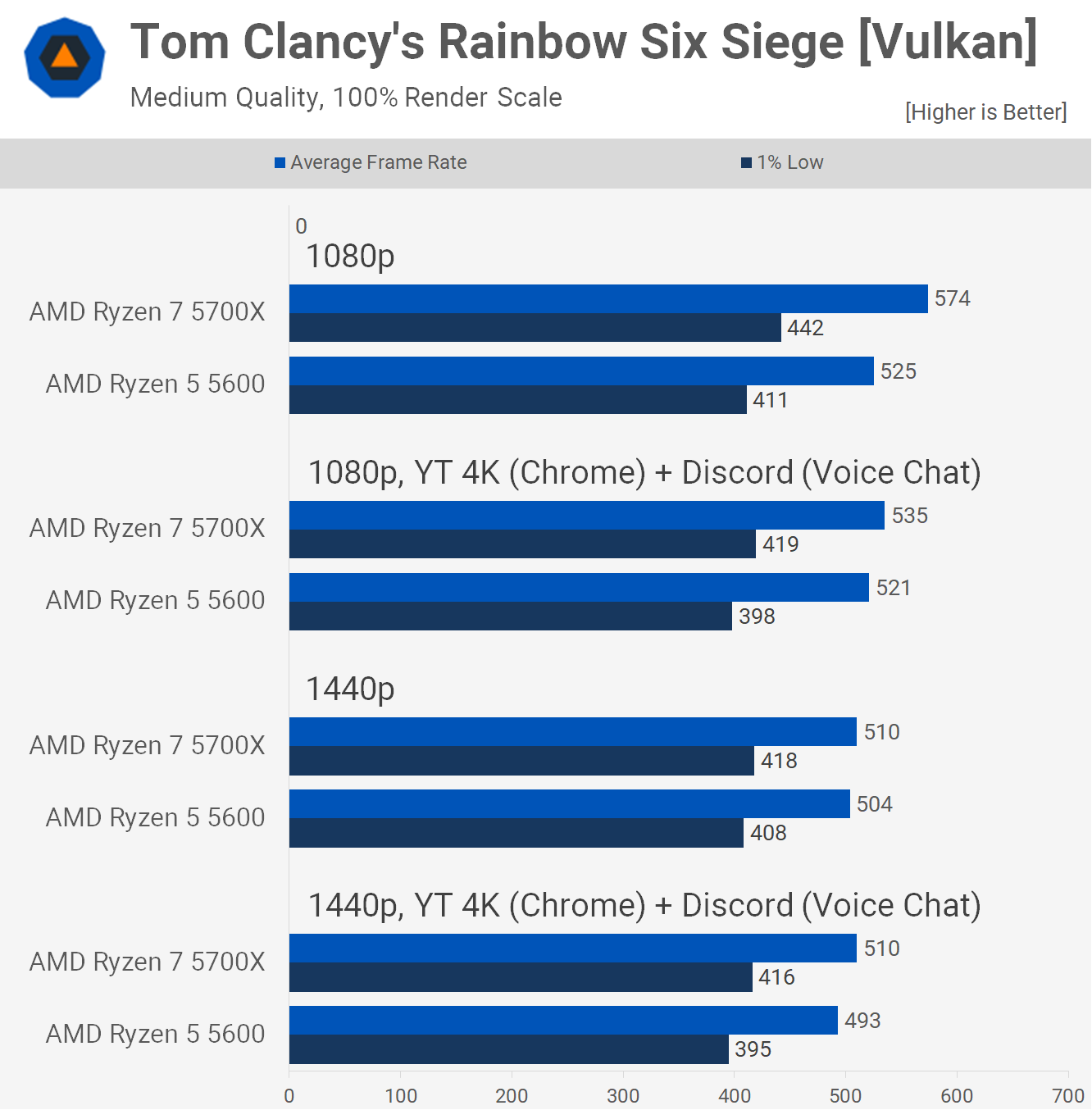
We decided to run Rainbow Six Siege again, but this time with a 4K video playing and again found that the performance hit was similar, with the 5700X and 5600 ending up closer in performance with the background tasks active when playing the game at 1080p.
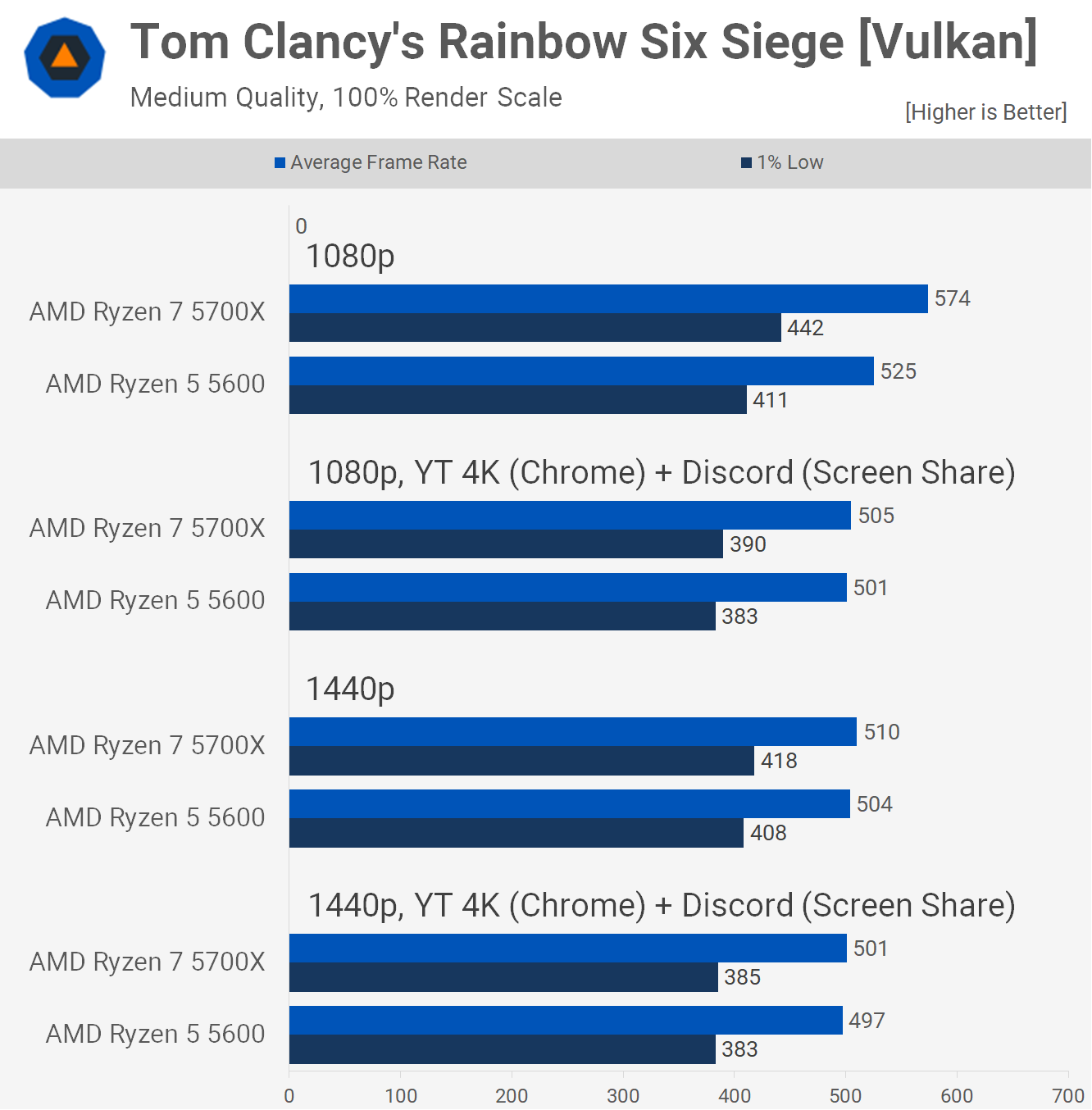
Finally, we ran Rainbow Six Siege but with the 4K video playing along with Discord screen sharing active and quite unexpectedly this reduced the performance of the 5700X and 5600 to basically the same level, despite the 5700X being up to 9% faster without the background tasks active. That's the opposite of what you'd expect to see. We have to assume there's some kind of Zen 3 bottleneck that's limiting performance with these additional tasks running, and the extra cores of the 5700X aren't required or cannot be used to overcome this limitation.
What We Learned
After some testing we believe to have gathered conclusive evidence that playing YouTube videos and chatting on Discord doesn't require oodles of CPU resources and uses very little of a modern CPU, and these applications certainly don't require dedicated cores.
None of this is to say gamers shouldn't buy a Zen 3 CPU with more cores, such as the Ryzen 7 5700X (or the 5900X) as there are multiple reasons for why you might do so. But you certainly don't need that level of processing power to game. So if you're on a tight budget, a cheaper part like the Ryzen 5 5600 will serve you well and will likely be sufficient for years to come. We know many of you are gaming with active background tasks using this CPU or a similar model and have reported no performance related issues.
On a side note, some will be asking to test "actually CPU intensive games" such as Anno, Factorio, and Cities Skylines, for example, but these games will provide similar results to that of Far Cry 6 and CS:GO.
This is another common misconception that we regularly see commented. These games while often CPU limited, are not CPU intensive. Sadly they suffer from a software bottleneck that seems them peg just 1-2 cores of a modern processor at 100%, while leaving the other cores doing virtually nothing. The only reason this kind of games see performance gains with modern CPUs is because of the IPC uplift, not the increase in core count. The more cores you add the more cores you have sitting around doing nothing when playing lightly threaded games.
Then if you plan on streaming, a higher core count CPU of the same architecture will be of benefit. Having said that, if you're streaming using a single PC you're almost always going to be better off using your GPU and NVENC appears to still be the best option.
My personal choice is to build a second less expensive PC to handle all the encoding. There are other benefits beyond stream quality such as stability, but I won't get too derailed by the streaming angle. In short, if you want to stream from your gaming PC more cores will help, though we recommend you don't use the CPU anyway.
Bottom line, if you're doing something beyond light background tasks, which is exactly what Discord and playing a YouTube video is for a modern processor, then spending more money on a more capable CPU is obviously going to be of benefit. We still strongly believe that for most gamers this is going to be a niche use case, and we doubt encoding a 4K video in Premiere on the 5700X is going to lead to a desirable gaming experience anyway.
On that note, we can't think of a realistic scenario where the 5700X will deliver an acceptable gaming experience, but the 5600 would crumble. Of course, we're open to suggestions and more than happy to keep this multitasking benchmark series going, so as always please provide your feedback and suggestions as it might lead to our next big benchmark test.
